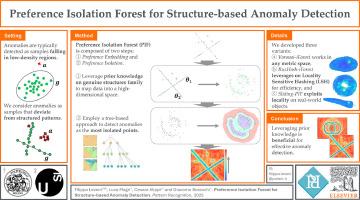基于结构的异常检测的偏好隔离林
IF 7.6
1区 计算机科学
Q1 COMPUTER SCIENCE, ARTIFICIAL INTELLIGENCE
引用次数: 0
摘要
我们解决了检测异常作为不符合由低维流形表示的结构化模式的样本的问题。为此,我们设想了一个通用的异常检测框架,称为偏好隔离森林(PIF),它结合了基于自适应隔离方法的优点和偏好嵌入的灵活性。关键的直觉是通过拟合低维流形将数据嵌入到高维偏好空间中,并将异常识别为孤立点。我们提出了三种隔离方法来识别异常:i) voronoi - ifforest,最通用的解决方案,ii) ruzhashi - ifforest,避免通过局部敏感哈希显式计算距离,以及iii)滑动- pif,利用局域性提高效率和有效性。本文章由计算机程序翻译,如有差异,请以英文原文为准。

Preference isolation forest for structure-based anomaly detection
We address the problem of detecting anomalies as samples that do not conform to structured patterns represented by low-dimensional manifolds. To this end, we conceive a general anomaly detection framework called Preference Isolation Forest (PIF), that combines the benefits of adaptive isolation-based methods with the flexibility of preference embedding. The key intuition is to embed the data into a high-dimensional preference space by fitting low-dimensional manifolds, and to identify anomalies as isolated points. We propose three isolation approaches to identify anomalies: i) Voronoi-iForest, the most general solution, ii) RuzHash-iForest, that avoids explicit computation of distances via Local Sensitive Hashing, and iii) Sliding-PIF, that leverages a locality prior to improve efficiency and effectiveness.
求助全文
通过发布文献求助,成功后即可免费获取论文全文。
去求助
来源期刊

Pattern Recognition
工程技术-工程:电子与电气
CiteScore
14.40
自引率
16.20%
发文量
683
审稿时长
5.6 months
期刊介绍:
The field of Pattern Recognition is both mature and rapidly evolving, playing a crucial role in various related fields such as computer vision, image processing, text analysis, and neural networks. It closely intersects with machine learning and is being applied in emerging areas like biometrics, bioinformatics, multimedia data analysis, and data science. The journal Pattern Recognition, established half a century ago during the early days of computer science, has since grown significantly in scope and influence.
 求助内容:
求助内容: 应助结果提醒方式:
应助结果提醒方式:


